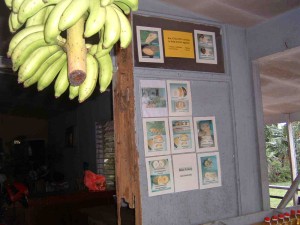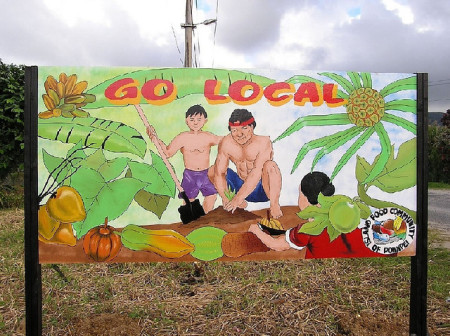- Sometimes all it takes is a goat.
- Or a camel.
- I wonder how either would figure into a metric for a sustainable diet. Wonder if these people will be interested in those metrics.
- Cassava figures in lots of different ways.
- No word on whether carbon dioxide will affect its nutrient content the way it does with other crops.
- Who cares, it’s yield we’re after. Well, that’s in trouble too in some parts of Africa.
- That’s the only way those African seed start-ups are going to survive.
- Yeah, but disease resistance is important, Shirley. PlantVillage gets a blog.
- And weeds? Don’t forget the weeds. Although of course some of them you can eat. Put that in your metrics.
- Meanwhile, France starts to re-wild. Would love to see some wild relatives in the Bois du Boulogne. Livestock wild relatives, not your crazy cousin on his gap year.
- And now we can figure out what climate change might do to them. I guess this thing might work for European animals. Says here it works for Australian trees.
- Speaking of France, garlic is quintessentially French, isn’t it? Well, maybe, but it’s also very Korean, in its black, cured form.
Nibbles: Coffee rust, Wheat blast, Livestock yield gap, Livestock adaptation, Extension, Med diet, Organic < conventional, Douglas fir breeding, Best moustache in cryo, Fortifying rice
- Coffee rust is doing a number on livelihoods in Central America.
- Wheat blast could do the same in South America.
- ILRI DG on smallholder livestock producers: one-third don’t have the conditions in which to be viable, one-third can go either way and one–third can be successful. I suppose all of them are going to need adaptation options.
- Not to mention extension services.
- Meanwhile, bureaucrats busy protecting the Mediterranean diet.
- The inevitable productivity penalty of organic.”
- Douglas fir ready for its genomic closeup.
- Cryopreservation update, with video goodness.
- Lots of ways to skin the malnutrition cat: zinc and rice.
Micronesian memories
Jonathan Gourlay’s wonderful dissection of his predictably disastrous experience as an outsider running a shop in Micronesia, One Small Store, struck a chord for a number of reasons. First, the great writing. Here’s a sample, chosen from many possibilities:
In Kitti, giant flat basalt stones are still lined up in two rows of three in the center of the feast house, each clanging with its own tone as shirtless men pound stone on stone, mashing up the thick, strong kava (called sakau) for the feast. The musical clacking and clanging of stones begins chaotically and then, as the kava turns gray and viscous, coalesces into one rhythmic song, calling the gods and people to the feast house. You can still join this song. You sit and mash the sakau root with the other sakau pounders around the ancient rock. But you cannot lead the song of the stones. The song just happens, as it has for centuries, when it happens. And when it is complete, you can still drink the sakau. If the sakau is strong, you become the stillest thing in the universe. An observer of life from outside of life. Everything, the ocean, the mango and mangrove trees, the barking dogs, the sweep of time, seems abstract and small because you also feel abstract and small. And perhaps there is a foreigner, a mehn wai, in this group of sakau drinkers. A teacher or a lawyer, someone useful but ultimately unimportant. They are welcome to stay and welcome to leave. What has remained, for hundreds of years, is the clang of the rocks. What has remained, through waves of sailors, missionaries, and invading armies, is the calm of the sakau root sinking into the drinkers, whether they bear a centuries-old title like soum or soulik or souwel or the simple title of mehn wai. They sneak into the ceremony, these interlopers, and they always sneak away again, one way or another.
Then there are the numerous references to the biodiversity of Pohnpei, including of the agricultural kind — such an important part of island life. Kava, as in the extract above, for sure; but also, say, sea cucumbers and betel nut. 1 And, as well, the evocation of how the traditional foods and way of life this biodiversity represents and underpins are being eroded by “things like spam, corned beef, …rice, and something called ‘coco’—a mixture of unripe mango, sugar-free Kool-Aid, and soy sauce.” It all brought back memories of my own time in the region; although thankfully it was not as challenging as Mr Gourlay’s, I think I know how he feels.
 And among those memories are many — both happy and painful — of my friend the late Lois Englberger, who worked so hard for the health and nutrition of the people of Pohnpei. For all I know, it was in Mr Gourlay’s very shop that I took this photo, when I visited the island back in 2004. You’ll have to click on it to see it properly, but it’s an example of Lois’ efforts to communicate the evidence that people on the island could improve their nutrition and well being by going back to eating Pohnpei’s unfortunately neglected — and disappearing — orange bananas (and other crop varieties high in Vitamin A precursors, for that matter). That’s ten years ago. Wow. Let me leave you with Lois’ photo of one of the billboards spreading her message on the island, and which Mr Gourlay would, I suspect, find amusing now, if he didn’t then.
And among those memories are many — both happy and painful — of my friend the late Lois Englberger, who worked so hard for the health and nutrition of the people of Pohnpei. For all I know, it was in Mr Gourlay’s very shop that I took this photo, when I visited the island back in 2004. You’ll have to click on it to see it properly, but it’s an example of Lois’ efforts to communicate the evidence that people on the island could improve their nutrition and well being by going back to eating Pohnpei’s unfortunately neglected — and disappearing — orange bananas (and other crop varieties high in Vitamin A precursors, for that matter). That’s ten years ago. Wow. Let me leave you with Lois’ photo of one of the billboards spreading her message on the island, and which Mr Gourlay would, I suspect, find amusing now, if he didn’t then.
Nibbles: Food future, Bean breeding 101, Yield gaps, Mitigation strategies, Sparing vs sharing, Diverse diets, Open seeds, Fake seeds, Florida citrus threat, Hot chicks, Nutrition nuggets
- Food? We don’t need no stinking food.
- Bean breeder begs to differ.
- Where we could do with more food.
- Nobody’s talking about mitigation any more. Oh yes they are.
- Land shparing is the answer.
- ICRAF decides to gather evidence for the benefits of agroforestry for nutrition.
- More on those open source seeds. Which I hope nobody will counterfeit.
- Florida needs new grapefruits, whether open source or not.
- Naked neck chickens look weird, but they may be really heat resistant, so get over it. Ghana has.
- Canadian grad students summarize nutrition research in a pithy sentence. Sound familiar?
Nibbles: Global plant cover, Veggies in Africa, Ancient middens, Raspberry fruit colour, Citrus greening, Jordan biodiversity, US nutrition, Subsidies, Seed and voucher fair, Bean diversity, Grape mildew fight
- GIS geeks sort out land cover at last.
- Role of vegetables in combating malnutrition in Africa. Author offers pdf of paper.
- Ancient native American middens just keep on giving.
- Raspberry colour good predictor of various fruit post-harvest characteristics. Good short-cut for breeders.
- Getting to the root of citrus greening. Scary disease.
- Freaky stuff about using frog eggs to figure out the genetics of grapevine’s susceptibility to another scary disease.
- Video of our friend Dr Nigel Maxted on Jordan’s socioeconomically important plants.
- Physician, heal thyself. Indian tells USAID to take care of its own food insecurity.
- How to create subsidies that promote biodiversity, in a model, which is probably highly unrealistic.
- Very realistic notes from a seed and voucher fair in Malawi.
- And anecdotes on the benefits of bean diversity in Uganda.
